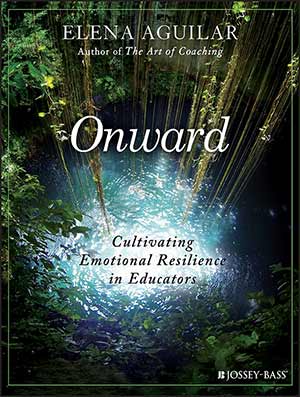Educators encounter hundreds of moments like these every day. We are challenged over and over and over by things that students do, or the unplanned fire drill, or the announcement of a mandatory meeting on Wednesday afternoon, or an upset parent showing up at our door five minutes before school starts, or the broken copy machine, or a request that we cover someone else’s class during our prep because their sub didn't show, or any number of other things. Alone, these are minor inconveniences, but the sum total of these moments feels exhausting, depletes our resilience, and contributes to burnout. There is no moment more important for educators to attend to than this one between stimulus and response. If we slow down and examine these moments, if we cultivate new responses, we might just transform our schools into places where we all thrive.
Change is the only thing we can count on. It will rain when we wish it wouldn’t, kids will say obnoxious things when we’re exhausted, leaders will come and go. However, we have tremendous power in how we interpret what happens and, therefore, in how we respond to big and little incidents that we didn’t anticipate, don’t want, or don’t like. The opportunity for resilience originates in how we make sense of the things that happen, because interpretation dictates actions. There are many ways to interpret a student’s obnoxious comment at the end of a rainy Friday, and each of those interpretations will lead us to act in a different way. Each of those actions will have intended and unintended consequences, ripples of impact on ourselves, our class, and our relationship to that individual student. We can make a choice in these moments.
Let this sink in: We can pinpoint the exact moment when resilience can be cultivated. You can actually do something about how you experience every day; you don’t have to be a victim of the turmoil and unpredictability of the world. Change is a given in life; how you respond is within your control.
I have no doubt that we all enter this field of work because we want to positively impact young people. The key to achieving our purpose lies in the moment between stimulus and response. We can meet our commitment to educational equity when we examine this moment and cultivate behaviors different than those in which we habitually engage. By cultivating resilience, we can fulfill the intentions that brought us into this profession. In addition, with this knowledge, we can do something about the exodus of teachers who quit because of burnout. We can offer our students more stability and continuity, as well as role models for managing the inevitable challenges of life.
RESILIENCE: THE WHAT, WHY, AND HOW
Simply put, resilience is how we weather the storms in our lives and rebound after something difficult. The most important thing to know is that you can increase your resilience; it's a set of adaptive behaviors. In this book, I hope to guide you in a journey to discover the resilience that already exists within you, and to discover many ways to cultivate your resilience.

Resilience is in great part about our attitude and behaviors; that’s what we'll focus on in this book. However, it’s also important to acknowledge that our ability to be resilient is also connected to our circumstances, which we may have only limited ability to influence. Furthermore, researchers have found that there are neurobiological underpinnings of emotional resilience (Osório, Probert, Jones, Young, and Robbins, 2017). This research seeks to understand why there’s such variation in the way people respond to adversity: Some people overcome unbelievable hardship, whereas others’ lives are completely derailed by intense levels of stress. Various mechanisms in our bodies, and specifically our brains, work in concert to make us more or less stress resilient across our life span. Our genetic makeup may play a role: We may actually be born with a set amount of resilience. The emerging field of epigenetics is exploring this question of how stressors that our ancestors experienced might impact our level of resilience.
Although this research is interesting and someday may point to very useful implications, we'll focus on this fact: A substantial amount of our ability to be resilient is fostered in our daily habits. This is good news. Here’s an expanded definition of resilience, which forms that basis for this book. Resilience is
- A way of being that allows us to bounce back quickly from adversity, and stronger than before, so that we can fulfill our purpose in life.
- An adaptive, dynamic process that includes an individual’s interactions over time in a complex environment. Context plays a role; resilience is not simply a function of one individual’s behavior. Who we are and where we are impact our ability to cultivate resilience.
- Cultivated through engaging in specific habits and by fostering specific dispositions.
- What enables us to thrive, not just survive.
WHY WE MUST FOCUS ON RESILIENCE
Schools are stressful places. Regardless of whether you teach in an established, well-resourced private or suburban school or in an underfunded school in an underserved community, teaching is emotional work and is inherently stressful. In part, this is the nature of being in a helping profession and serving young people in complex organizations. Healthy stress can be okay; it can challenge us and help us develop. However, in many of our schools, healthy stress is frequently displaced by toxic stress. Toxic stress occurs when demands consistently outpace our ability to cope. Toxic stress first manifests as decreased productivity, and escalates to more serious symptoms such as anxiety, dissociation, frustration, and, eventually, burnout. Roughly half a million US teachers leave the profession each year—a turnover rate of over 20% (Alliance for Excellent Education, 2014).
School leaders—both site leaders and central office leaders—must focus on boosting the resilience of staff as a lever for school transformation. Teacher attrition among first-year teachers has increased about 40% in the past two decades ( Ingersoll, Merrill, and Stuckey, 2014). A range of factors, such as morale, accountability expectations, and salaries, certainly contribute to the attrition problems, but stress and poor management of stressors are also rated as a top reason why teachers leave the profession (Carver-Thomas and Darling-Hammond, 2017).
Burnout is physical and emotional fatigue—and surely we can do something about that. This rate is much higher in urban areas, in secondary classrooms, and in hard-to-staff content areas such special education, math, science, and foreign languages (Carver-Thomas and Darling-Hammond, 2017). It is estimated that teacher turnover costs school districts upwards of $2.2 billion per year (Alliance for Excellent Education, 2014) and the cost of replacing a teacher in an urban district exceeds $20,000 per teacher (Carver-Thomas and Darling-Hammond, 2017). For site administrators, turnover rates may be comparable, particularly in urban areas, but the data is not systematically collected as it is for teacher attrition.
Lack of resilience, therefore, has a financial cost and contributes to staff instability, which in turn negatively impacts student learning and experience. High turnover rates at schools make it hard to accumulate professional capital, hinder the implementation of programs, contribute to low levels of trust among stakeholders, and make staff and student culture fragile. It would simply make good sense, from a financial perspective, to focus on increasing staff resilience.
The end goal, of course, is not just to retain warm adult bodies in classrooms but to meet the needs of our students. Kids need passionate, effective, committed educators. In order to retain such people, school leaders need to provide teachers with resources to meet the challenges they’ll encounter in their work so that they can learn from those challenges, surmount them, and fulfill their purpose. And our purpose is to ensure that we are working in, teaching in, and leading organizations where every single child thrives—academically, socially, and emotionally. We must cultivate resilience so that all children feel that they belong to a resilient community, so that all children graduate and are eligible for the college or career of their choice, and so that all children have an expansive tool set to contribute to our society.




